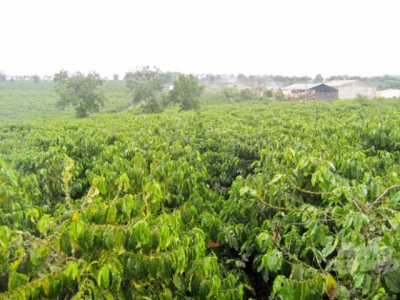Vietnam pushes up exporting coffee to China

China’s coffee import rose sharply in the first 9 months of this year and will keep rising in the coming months till year end.
A coffee farm in Dong Nai. Photo: Thanh Son.
There will have a big chance for Vietnamese coffee industry. Chinese have a long tradition of drinking tea, but coffee is gradually becoming a familiar drink in the society, especially with the city dwellers and among youths.
In particular, instant coffee holds a significant share in the Chinese coffee market due to its convenience and influence of Western lifestyle among young families and middle-class consumers.
China’s coffee import increases continuously in recent years. According to China Coffee Association, in recent years, coffee consuming in China grows by 15% per year. Another international source says, Chinese coffee market will reach an average growth of 10.15% in the 2021 - 2026 period.
It is notably that the Covid-19 pandemic in the last two years has not affected the consuming demand in China, as Chinese change their habit to have the drinks at home and coffee is one of those.
China produces coffee too, but the output is quite modest, only about 1.8 million bags (equivalent to 108 thousand tons), much lower than the demand. Therefore, coffee imports into China are on a very strong growth trend.
According to the General Administration of Customs of China, the country's coffee import turnover in September 2021 reached US$ 53.84 million, up 62.4% compared to September 2020. In the first nine months of 2021, China's coffee import turnover reached US$ 387.76 million, up 75.3% over the same period in 2020.
The supply of coffee for China is diverse, with about 80 supplying markets. In which, the main coffee supplying markets for China include Guatemala, Ethiopia, Vietnam, Malaysia, Brazil...
Vietnam is currently the third largest source of coffee for the Chinese market. In the first 9 months of this year, Vietnam's coffee imports into China reached US$ 46.28 million, up 69.5% over the same period in 2020. Vietnamese coffee accounted for about 12% of the China's total import turnover.
China is currently one of the 10 largest markets for Vietnamese coffee. Information from the General Department of Vietnam Customs shows that, in the first 9 months of this year, coffee exports to China reached 40,000 tons, with a turnover of US$ 90 million.
With the above quantity and value, China is the 10th largest market in terms of volume and 8th in terms of turnover of Vietnam's coffee exports. This is a very impressive breakthrough of coffee exports to China, as not long ago, this country was still outside the top 10 largest markets of Vietnamese coffee.
In particular, China is one of the leading markets for Vietnamese processed coffee. In the first nine months of this year, exports of processed coffee to China reached US$ 44.6 million, up 14% over the same period last year. China is currently the second largest market for Vietnam’s processed coffee (the largest market is the Philippines).
China's coffee import demand is still increasing in the last months of the year. In October, the amount of Vietnamese coffee exported to China increased significantly compared to September.
According to the Department of Import Export (Ministry of Industry and Trade), the Chinese coffee market is highly competitive. Therefore, Vietnam's coffee industry needs to actively innovate designs, product packaging and improve quality to meet the increasing demands of Chinese consumers to increase market share.
Besides, businesses can focus on social media platforms and online distribution channels for promotion and product branding.
Related news
 Pepper exports forecasted to reach 1 billion USD
Pepper exports forecasted to reach 1 billion USD Pepper exports this year rose sharply and are forecasted to continue in the remaining months, 2021 exports turnover can reach 1 billion USD.
 High income with Thai jackfruit and Taiwanese mango on hilly land
High income with Thai jackfruit and Taiwanese mango on hilly land Only a few years after converting nearly 1.3 hectares of rice cultivation on hilly land to Thai jackfruit and Taiwanese mango, this model has generated hundreds
 When water source for agriculture burdened with series of contamination
When water source for agriculture burdened with series of contamination Agriculture production has resulted in a range of negative consequences that contribute to environmental contamination, most notably water pollution.